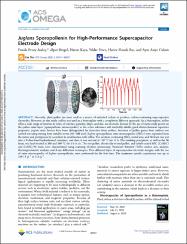| dc.contributor.author | Atalay, Funda Ersoy | |
| dc.contributor.author | Bingöl, Alper | |
| dc.contributor.author | Kaya, Harun | |
| dc.contributor.author | Emre, Yıldız | |
| dc.contributor.author | Baş, Hatice Hande | |
| dc.contributor.author | Culum, Ayşe Asiye | |
| dc.date.accessioned | 2021-06-04T12:57:08Z | |
| dc.date.available | 2021-06-04T12:57:08Z | |
| dc.date.issued | 2020 | en_US |
| dc.identifier.citation | Atalay, F. E., Bingol, A., Kaya, H., Emre, Y., Bas, H. H., & Culum, A. A. (August 18, 2020). Juglans Sporopollenin for High-Performance Supercapacitor Electrode Design. Acs Omega, 5, 32, 20417-20427. | en_US |
| dc.identifier.issn | 2470-1343 | en_US |
| dc.identifier.uri | https://doi.org/10.1021/acsomega.0c02355 | |
| dc.identifier.uri | https://hdl.handle.net/20.500.12899/186 | |
| dc.description.abstract | Recently, plant pollen has been used as a source of activated carbon to produce carbon-containing supercapacitor electrodes. However, in this study, pollen was used as a biotemplate with a completely different approach. As a biotemplate, pollen offers a wide range of varieties in terms of exterior, porosity, shape, and size. An electrode formed by the use of metal oxide grown on the pollen exine layer (sporopollenin microcapsules) as the active substance will inevitably exhibit good electrochemical capacitive properties. Juglans male flowers have been distinguished by dissection from anthers. Isolation of pollen grains from anthers was carried out using sieving from suitable sieves (45-200 mu m). Juglans sporopollenin exine microcapsules (SECs) were separated from the intine and protoplasm by acetolysis in combination with reflux. The solution containing SECs, metal ions, and Ni foam was put into a Teflon-lined hydrothermal container, and then, it was reacted at 120 degrees C for 15 h. The resulting precipitate, as well as the Ni foam, was heat-treated at 300 and 360 degrees C for 3 h in air. The raw pollen, chemically treated pollen, and cobalt-coated SEC (CoSEC) and CoSEC/Ni foam were characterized using scanning electron microscopy, Brunauer-Emmett-Teller surface area analysis, thermogravimetric analysis, and X-ray diffraction techniques. Two different types of supercapacitor electrode designs, with the use of exine microcapsules of Juglans sporopollenin, were performed for the first time. The maximum specific capacitance was up to 1691 F g(-1) at 5 A g(-1). | en_US |
| dc.language.iso | en | en_US |
| dc.publisher | American Chemical Society | en_US |
| dc.relation.ispartof | ACS Omega | en_US |
| dc.rights | info:eu-repo/semantics/openAccess | en_US |
| dc.subject | Cobalt oxide | en_US |
| dc.subject | Pollen | en_US |
| dc.subject | Morphology | en_US |
| dc.subject | Nanostructures | en_US |
| dc.subject | Arrays | en_US |
| dc.title | Juglans Sporopollenin for high-performance supercapacitor electrode design | en_US |
| dc.type | Article | en_US |
| dc.authorid | 0000-0002-6090-0559 | en_US |
| dc.department | MTÖ Üniversitesi, Mühendislik ve Doğa Bilimleri Fakültesi, Mühendislik Temel Bilimleri Bölümü | en_US |
| dc.institutionauthor | Kaya, Harun | |
| dc.identifier.doi | 10.1021/acsomega.0c02355 | |
| dc.identifier.volume | 5 | en_US |
| dc.identifier.issue | 32 | en_US |
| dc.identifier.startpage | 20417 | en_US |
| dc.identifier.endpage | 20427 | en_US |
| dc.relation.publicationcategory | Makale - Uluslararası Hakemli Dergi - Kurum Öğretim Elemanı | en_US |
| dc.identifier.scopus | 2-s2.0-85091036612 | en_US |
| dc.identifier.scopusquality | Q1 | en_US |
| dc.identifier.wos | WOS:000563015100050 | en_US |
| dc.identifier.wosquality | Q2 | en_US |
| dc.indekslendigikaynak | Web of Science | en_US |
| dc.indekslendigikaynak | Scopus | en_US |


















